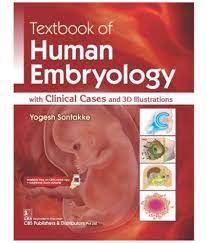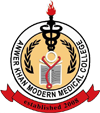Anwer Khan Modern Medical College
Library Management System

| Title: | Textbook of human embryology: with clinical cases and 3D lllustrations |
| Author Name: | Yogesh Ashok Sontakke |
| Author Sur Name: | SONTAKKE, Yogesh Ashok. |
| Author information: |
|
| Edition/Published: | 1st ed. _New Delhi : CBS Publishers , 2019 |
| New to this edition: |
|
|
Physical Description: viii, 320p., : 27.8cm |
| Includes Index: | 315-320 |
| ISBN No's: | 978-93-88108-37-9 |
| Bar Code's: | |
| Shelf Location's: |
| Classification | |
| Subject: | Embryology |
| Dewey Class No: | 612.6 |
| LC Classification: | RG629 |
| Other's Book Information | |
| Book ID No: | 2670 |
| Total Books: | 1 |
| Date of collection's: | 18-Mar-2023 |
| Donation / Purchase: | Donation |
| Language: | English |
| Status: | Available |
| Department: | Anatomy |
| Synopsis: |
|
| Description: |
|
| Key Features: |
|
| Summary: |
"Textbook of Human Embryology: With Clinical Cases and 3D Illustrations" is a comprehensive textbook that provides a detailed overview of the development of the human embryo from fertilization to birth. The book is authored by Dr. Yogesh Ashok Sontakke, a renowned Indian medical author and anatomist, and includes clinical cases and 3D illustrations to help students understand the complex processes of embryology. Some of the key topics covered in the book include:
Overall, "Textbook of Human Embryology: With Clinical Cases and 3D Illustrations" is a valuable resource for medical students, anatomists, and anyone else interested in understanding the complex processes of human embryology. |
| Abstract: |
The book is a concise textbook that has been written in easy-to-understand language for ease of exam revision. The book has 3D illustrations that provide images of embryological changes, while flowcharts make the revision of developmental sequences easier. Tables summarise all the essential facts and boxes focus on the most important topics students need to remember |
| Preface: |
This Textbook of Human Embryology has been written keeping in mind the requirements of students and teachers. Due to the complexity of the subject, readers face difficulty in understanding and imagining the developing human structures. Hence, in the present book, an attempt has been made to provide all necessary information for easy understanding. |
| Content: |
1. Introduction-1 |
Related Books
- Langman's medical embryology.
- Atlas of human anatomy
- Atlas of human anatomy
- Clinical anatomy by regions
- Gray's anatomy: the anatomical basis of clinical practice
- Junqueira's basic histology: text and atlas
- Textbook of anatomy upper limb and thorax: vol. 1
- Textbook of anatomy head, neck and brain: vol. 3
- Textbook of human osteology: with atlas of muscle attachments
- Textbook of human osteology: with atlas of muscle attachments
